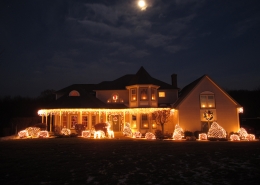When the facade produces electricity
Photovoltaic (PV) systems on roofs are now commonplace - on new and existing buildings. Increasingly, however, solar panels are also being mounted on facades, parapets or railings. Energeiaplus uses concrete building projects to show where the challenges and opportunities lie. PV on facades is also a topic at the 5th Symposium "Solar Building" on September 26, 2023, which is supported by the SFOE Energy Switzerland program.
Suva is written in white lowercase letters on the five-story office building near Paradeplatz in Zurich: on the facade of the 1960s building, the window fronts are striking, as are the dark bands of parapets between the individual floors. The buildings opposite are reflected in them. However, there is nothing to indicate that the six parapet strips can produce electricity.
The dark blue solar panels, which were installed as part of the overall renovation of the building, are custom-made so that they blend inconspicuously into the facade. According to the Zurich architectural firm SPPA Architekten, this is the first time that a building project with PV façade elements has been approved in the core zone of the city of Zurich.
The office building, which consists of two adjoining parts, is not a listed building. However, the character of the façade was to be preserved, so that the two parts of the building would form a single unit for the eye even after the renovation (see picture). The part with the new PV elements should therefore not stand out from the original glass and aluminum facade of the other part.
In addition to the façade, PV panels were also installed on the flat roof - as well as on the façade of the new roof structure, which houses the new technical control center. The planners expect to generate around 160 MWh of solar power per year, which will be earmarked in advance for the building's own consumption.
Solar architecture is also the topic of the 5th "Solar Building" symposium. Practical technical papers will show what photovoltaics can offer for architectural integration. The event is organized by the trade association Swissolar, the trade journal for architecture and construction TEC21, the Swiss Society of Engineers and Architects SIA, solarchitecture.ch and the Chair of Architecture and Building Systems at ETH Zurich. Click here for the program.
PV becomes invisible
More and more often, the entire facade of buildings is equipped with PV modules without the panels being recognizable as such from the outside. This is made possible by modules (based on amorphous silicate) with a matte surface, the color of which can be chosen differently. Such a façade was realized on a residential and office building in Stadtkreis 6 in Zurich by the architectural firm Viridén + Partner.
In total, the facade and roof surfaces of this building supply enough solar power to ensure that the annual energy balance for providing the indoor climate, lighting and other applications in the 30 residential and office units is positive, and almost one-fifth of the electricity produced can be fed into the power grid of the city of Zurich's energy supplier ewz as surpluses.
The combination of PV systems on the roof and the facades also helps to increase electricity production over the course of the year and, in particular, to extend the yield maxima from spring to fall. In the Schaffhauserplatz project in Zurich, intelligent energy management was also used to optimize self-consumption.
in the video, the architect of the building, the PV manufacturer, and the smart grid specialist from ewz explain the special features and opportunities of these glass facades.
https://youtu.be/2xQLlykps3s
The solarchitecture site has more examples of solar facades.
How widespread is the installation of PV on building facades in Switzerland? Energeiaplus asks Andreas Hekler. He is deputy managing director of Swissolar, the industry organization for everything to do with solar energy.
Andreas Hekler: PV facades still account for a small part of the total installed capacity in a year. However, Switzerland is taking a pioneering role in this topic and is at the forefront worldwide in terms of installed capacity and architectural integration. Finally, in densely populated Switzerland, a quarter of the solar potential on buildings is on facades. Vertically installed PV elements are important for the production of winter electricity, which we urgently need in Switzerland.
Especially in new buildings, solar roofs, tiles, facades or even balcony railings are already almost standard. Is this impression deceptive?
Photovoltaics come into their own when the use of the technology is defined early in the project process. This means that it can be taken into account in the project design and, for example, the building envelope can be planned appropriately or the use and consumption of the energy can be well coordinated. In the future, this balancing should not only be possible in the building or outbuilding, but also happen in a closer vicinity. In the law for a secure power supply with renewable energy (coat decree), so-called local electricity communities are provided for. These offer even more possibilities for the local use of decentrally produced solar energy. Such well and comprehensively planned projects then make sense ecologically, economically and in terms of efficient grid usage.
What is the situation with refurbishments?
There are first projects where a renovation of the facade with a replacement of the ceramic or aluminum panels by photovoltaic elements has been successfully implemented. One example is the complete renovation of the commercial building at Josefstrasse 84, Zurich by BKG Architekten or the SUVA Zurich building presented here. Suitable areas should be used, also from an urban or landscape planning point of view. For example, renovation with PV modules should always be considered in the case of a curtain-type, rear-ventilated façade. Solar-experienced architects and planners are well able to demonstrate such suitability to building owners.
How efficient are PV panels on facades compared to those on roofs?
Depending on the orientation of the PV elements according to the direction of the sky, the production curve changes. It is important that the surfaces are aligned in such a way that they are suitable for the corresponding building, the corresponding neighborhood, and the overall energy system. Thus, the primary goal is not to achieve the maximum amount of energy, but to produce additional energy when it is needed. This applies not only throughout the day, but also throughout the year. As mentioned, PV facades fit well into the production mix. For example, a south-facing solar façade produces about 30% less than a roof-mounted system with a 30° slope. But almost half of this yield occurs in the winter half-year.
Where do you see the challenges for PV systems on facades?
There are a growing number of good projects currently being planned or built. As a comparatively young technology, the processes must become more efficient and easier to calculate, which is why standards are needed in the relevant topics. This is evident, for example, in fire safety regulations. Swissolar is currently working on a state of the art paper, thanks to which most PV facades should be feasible without fire tests.
The biggest challenge for PV systems on facades, however, is to really address the issues of solar building, i.e. it takes the target of the building owners to want to generate PV electricity on the buildings, and it takes experienced architects, planners and installers to also implement these projects.
Above all, it is also important that the building culture changes in such a way that people are aware of the urgency of adapting to climate change or ensuring energy security with renewable energies. This will lead to the implementation of even more innovative projects, such as those that can be shown this year at the Solar Building Symposium.
Text and interview: Brigitte Mader, Communication, Swiss Federal Office of Energy
 Zeljko Gataric / SPPA Architekten
Zeljko Gataric / SPPA Architekten
 ShutterstockLister les programmes de promotions énergétiques
ShutterstockLister les programmes de promotions énergétiques  shutterstockCROSSDat - An open energy data platform for Switzerland
shutterstockCROSSDat - An open energy data platform for Switzerland  L’hiver est là, les températures montent
L’hiver est là, les températures montent  ShutterstockEclairer sa maison pour Noël, sans surconsommation!
ShutterstockEclairer sa maison pour Noël, sans surconsommation! 
 Minergie
Minergie
Neuste Kommentare